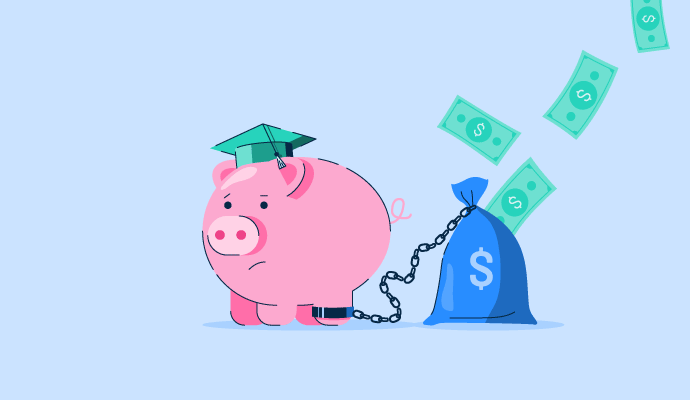October 30, 2023
 by Lauren Pope / October 30, 2023
by Lauren Pope / October 30, 2023

In today's world, many students are understandably concerned about their student loan debts.
Until September 2020, the government had been providing relief by temporarily pausing student loan payments due to the COVID-19 pandemic. However, the Supreme Court rejected a significant proposal from the Biden Administration to forgive up to $20,000 in loans per borrower.
Given these challenges, many students actively seek practical solutions for debt relief. One such solution gaining attention is the use of loan software. This technology simplifies the loan management process, making it more accessible and manageable, even as the rules surrounding student loans continue to change.
Moreover, there are alternative avenues for assistance, such as the Public Service Loan Forgiveness (PSLF) program, which can provide relief to eligible borrowers.
The PSLF program allows eligible government and not-for-profit workers to get full forgiveness of their federal student loan debt if they meet specific requirements set by the Department of Education.
The program can be complex, so it's important to grasp how it works to figure out if you qualify and to ensure you receive credit for your efforts.
Let's continue reading to delve deeper into the details.
The PSLF is a student loan repayment initiative signed into law in 2007 by President George Bush as a response to the growing student loan crisis. It was designed to reward graduates who entered public service careers such as nonprofit work, teaching, or government jobs.
To be eligible, applicants need to work in the public service field for ten years before qualifying to have their loans forgiven. The first batch of eligible recipients hit their ten-year mark in 2017, and participants applied in waves.
The results?
According to Forbes, 640 borrowers received public service loan forgiveness based on approximately 132,000 processed applications. That's less than 0.5%.
How did a program designed to forgive such a large number of student loans manage to reject 99% of the people who applied for it?
The answer is in the details.
The PSLF initiative aimed to incentivize post-graduation career choices that involve public service.
If you qualify for PSLF, you can get your remaining student debt forgiven after making ten years' worth of monthly payments, for 120 payments, while you work for the government or a nonprofit.
Use the PSLF Help Tool on the student aid website to determine your eligibility based on the types of loans you and your employer have.
The PSLF Help Tool, provided by the Department of Education, aids borrowers in comprehending forgiveness prerequisites.
PSLF requires public service employees with federal student loans to certify their full-time employment with a government or nonprofit organization through a designated form known as the PSLF Form. This form necessitates confirmation of past or current employment by the employer.
The submitted form is then reviewed to ensure it's complete and to determine whether your loans and employment meet the criteria for the PSLF Program.
PSLF went through temporary changes because of the Coronavirus pandemic.
Note: You can find out how many qualifying payments you have made when you log in to your account with the PSLF servicer. You can also view your loan details or your most recent billing statement.
If you believe you meet the criteria for the PSLF program, here's a step-by-step guide to kickstart the application process using the PSLF help tool:
Note: You'll need your most recent W-2 form or your employer's federal employer identification number.
The PSLF help tool process can typically be completed in under 30 minutes.
If you manually submit your form, you must send it to MOHELA.
The form is then reviewed to ensure it's complete and determine whether your loans and employment qualify for the PSLF Program.
Suppose your PSLF form is approved for forgiveness. In that case, you'll be notified that the balance of your eligible federal direct loans will be forgiven. If you made payments after the 120th qualifying payment, those will also be refunded to you.
If it's determined that you are not eligible for loan forgiveness, you will be notified of this information and provided with the reason(s) you were determined to be ineligible.
Mastering the PSLF program can be challenging at times. Several problems can occur:
As expected, there has been a significant surge in applications for the PSLF program. What's noteworthy, however, is the substantial number of rejections. The high rejection rate can be attributed to several factors, the most prominent being a widespread misunderstanding of the program's requirements.
While these requirements may seem straightforward initially, they only scratch the surface of the program's intricacies. Many applicants who believed they met the basic criteria discovered, sometimes years into their repayment journey, that they did not qualify or had overlooked crucial details.
The primary reasons for the rejection of most PSLF applications appear to fall into four main categories:
The first mistake many applicants make is assuming they qualify for public service loan forgiveness based on their work. The reality is that your qualification for the program is based on who you're employed by, not the nature of your work.
Types of employers that qualify under PSLF:
It's not enough to hold a position with one of these employers. You must be employed full-time and complete an employment certification form every year.
If you switch jobs and your new employer doesn't qualify, the clock on your student loan forgiveness path is paused until you begin working for a qualified employer again.
The employment certification form isn't something you can set and forget. Neglecting to verify whether your employer counts as a qualifying employer or updating your employment information is one of the main reasons applications get rejected.
You should be submitting an employment certification form:
One of the main requirements for the program is working in public service for ten years while making loan payments. This step helps create a paper trail that makes it easy for the government to track your work in public service.
This is the trickiest part of the public service loan forgiveness program. To qualify, your loans must be direct or federal. A direct loan is a type of loan in which an institution lends directly to the borrower and involves no third-party lenders. These can include non-bank institutions, the government, or banks.
Qualifying repayment plans include all income-driven Repayment (IDR) plans:
Note: While payments made under the 10-year Standard Repayment Plan are qualifying, you might have to change to an income-driven repayment plan to benefit from PSLF. Under this plan, your loans will be paid in full once you have made 120 qualifying PSLF payments, so there would be no balance left to forgive unless periods of qualifying deferments or forbearances are included in your 120 qualifying payments.
If you have loans that don't qualify as direct loans, you can consolidate your loans. If you consolidate your loans, however, it resets the clock on your time in the program. For example, if you've been working toward a PSLF program for six years and then consolidate your loans, you start back at square one and have to make ten more years of payments.
This is the most important step to get right at the beginning. You don't want to do all the work of tracking your employers, paying your loans, and collecting the right information only to find out your loans don't qualify.
These repayment plans don't qualify for PSLF:
This reason for rejection can be the most confusing (and frustrating) because it's vague. In many cases, applications are rejected initially because there isn't enough information to prove you qualify for the program. An easy way to remedy this? Keep track of everything. Ten years is a long time, and misplacing important documents or files is easy.
Tip: Consider cloud content collaboration software for proactive data management. It lets you securely store and access documents from any device, ensuring your information remains safe even if your computer is lost or stolen.
While PSLF can erase substantial debt, it's not universally available, even for federal student loan borrowers.
If you're seeking alternative avenues for relief, here are some worth considering:
If you're considering a career in a government agency or a not-for-profit organization, you may find relief from your student loan debt through the PSLF program.
To enhance your chances of success, starting the application process sooner rather than later is a good idea, especially if you're uncertain whether your loans qualify for the program.
It's important to remember that careful planning and thorough documentation are crucial for overcoming common challenges in the process.
While it does require a decade of consistent payments and qualifying employment to be approved, the potential for complete debt forgiveness makes the effort worthwhile.
Ten years is quite a stretch, so make managing important documents a breeze with the top-notch document management software.
Lauren Pope is a former content marketer at G2. You can find her work featured on CNBC, Yahoo! Finance, the G2 Learning Hub, and other sites. In her free time, Lauren enjoys watching true crime shows and singing karaoke. (she/her/hers)
Think student loan repayment is a topic best left to politicians? Think again.
 by Lauren Pope
by Lauren Pope
Getting the right hire is key for any business.
 by Diksha Singh
by Diksha Singh
Talent management isn’t just another industry buzzword the big shots in Silicon Valley are...
 by Lauren Pope
by Lauren Pope
Think student loan repayment is a topic best left to politicians? Think again.
 by Lauren Pope
by Lauren Pope
Getting the right hire is key for any business.
 by Diksha Singh
by Diksha Singh


